Introduction
In the contemporary business landscape, the transition to cloud computing has emerged as a pivotal strategy for organizations seeking to enhance operational efficiency and drive innovation. Cloud migration involves the strategic relocation of data, applications, and critical business components from traditional on-premises infrastructures to dynamic cloud environments, presenting a wealth of opportunities for cost savings and improved scalability.
As enterprises navigate this transformative journey, understanding the various migration strategies—collectively known as the 6 Rs—becomes essential for optimizing resources and minimizing waste. However, the path to successful cloud adoption is fraught with challenges, from ensuring data security to aligning stakeholders across departments.
This article delves into the intricacies of cloud migration, offering a comprehensive overview of strategies, best practices, and the critical importance of meticulous planning in achieving a seamless transition. As organizations increasingly recognize the potential of cloud solutions, the insights provided herein will serve as a valuable guide for navigating this complex yet rewarding landscape.
Understanding Cloud Migration: An Overview
Migration to remote storage involves the strategic transition of data, applications, and other essential business elements from on-premises infrastructures to virtual environments. This shift offers significant advantages, including:
- Enhanced operational efficiency
- Substantial cost reductions
- Improved scalability
Numerous entities are finding efficient strategies to handle and enhance their digital expenses, which is crucial in today's competitive environment.
For instance, Drift successfully reduced its annual expenses for online storage by $2.4 million, showcasing the potential for significant savings through strategic management. As entities pursue digital migration through broad approaches to migrating into the cloud, they gain advantages such as:
- Improved data accessibility
- Enhanced collaboration abilities
- The chance to utilize advanced technologies like Artificial Intelligence and Machine Learning, which are currently being investigated by 17% of firms
Moreover, with global energy usage by data centers representing around 1% of the world’s total energy consumption, enterprises must take energy efficiency into account as an essential element in their digital transformation plans.
As Cody Slingerland, a FinOps certified practitioner, emphasizes, leveraging cloud solutions is crucial for organizations aiming to optimize their operations and drive innovation.
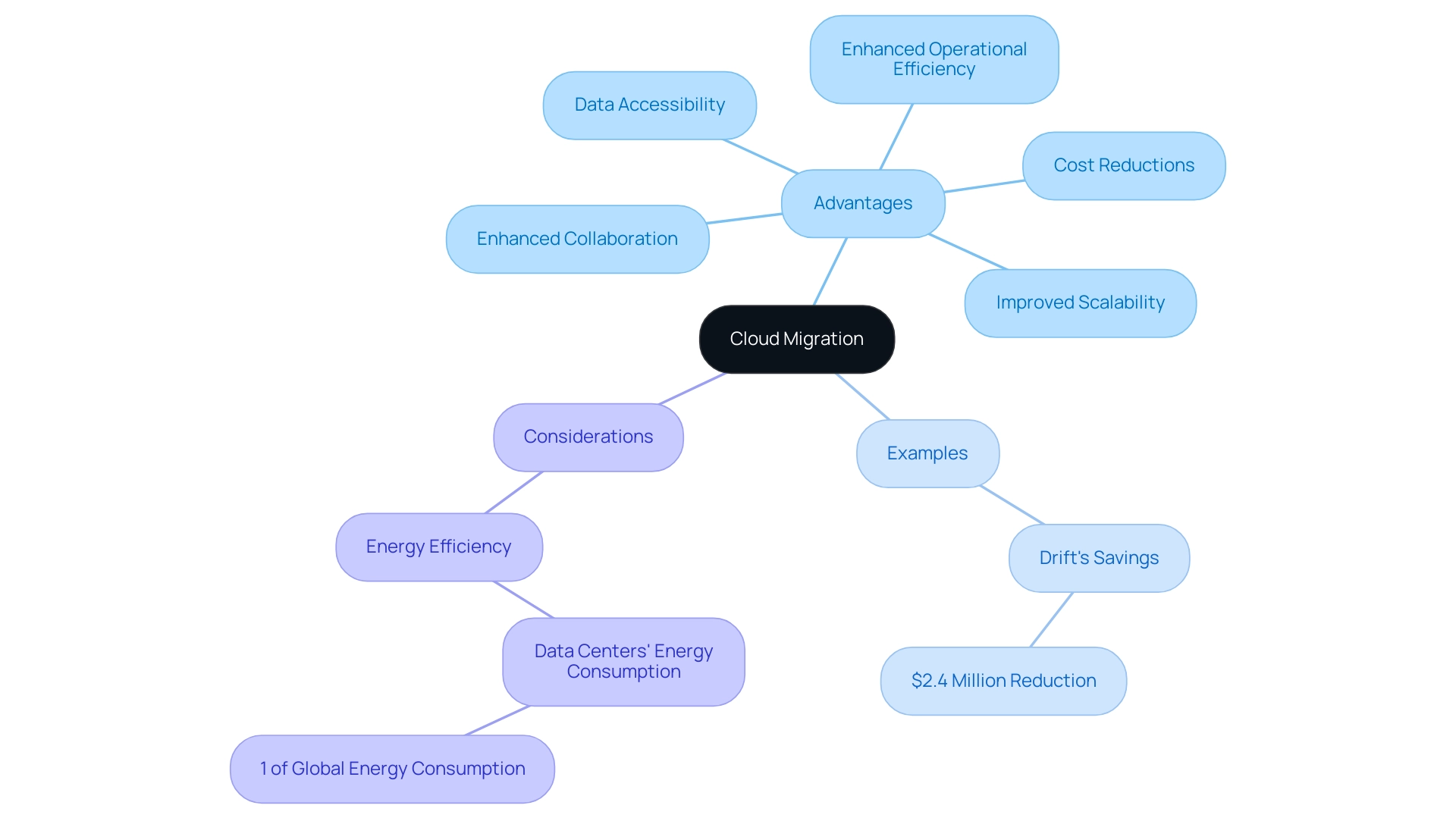
Exploring Cloud Migration Strategies: The 6 Rs and Beyond
Cloud migration methods are fundamentally categorized into six key approaches, often referred to as the 6 Rs:
- Rehost
- Replatform
- Refactor
- Retire
- Retain
- Repurchase
Each approach varies significantly in complexity and cost implications. Notably, 75% of organizations report an increase in waste associated with their spending on online services, with such waste potentially reaching as high as 47% of a budget.
This highlights the significance of selecting the appropriate relocation plan. Rehosting, or the 'lift-and-shift' approach, is generally the quickest method for transferring; however, it may not fully utilize the native features of the platform, resulting in possible inefficiencies. According to StormForge, "Most companies reported that as their spending on the virtual infrastructure increased, so did their waste in that area," highlighting the critical need for careful planning in the transition.
Conversely, Refactoring entails re-architecting applications to enhance performance for online environments, but this approach requires increased time and resource commitment.
When deciding on the most appropriate transition plan, organizations should carefully evaluate their unique needs, operational limitations, and long-term objectives by considering broad approaches to migrating into the cloud. Gartner predicts that by 2025, 85% of firms globally will embrace a cloud-first strategy, highlighting the necessity of making informed choices about transitioning to online services. Grasping these strategies and their implications is vital for CTOs seeking to navigate the increasingly intricate realm of computing effectively.
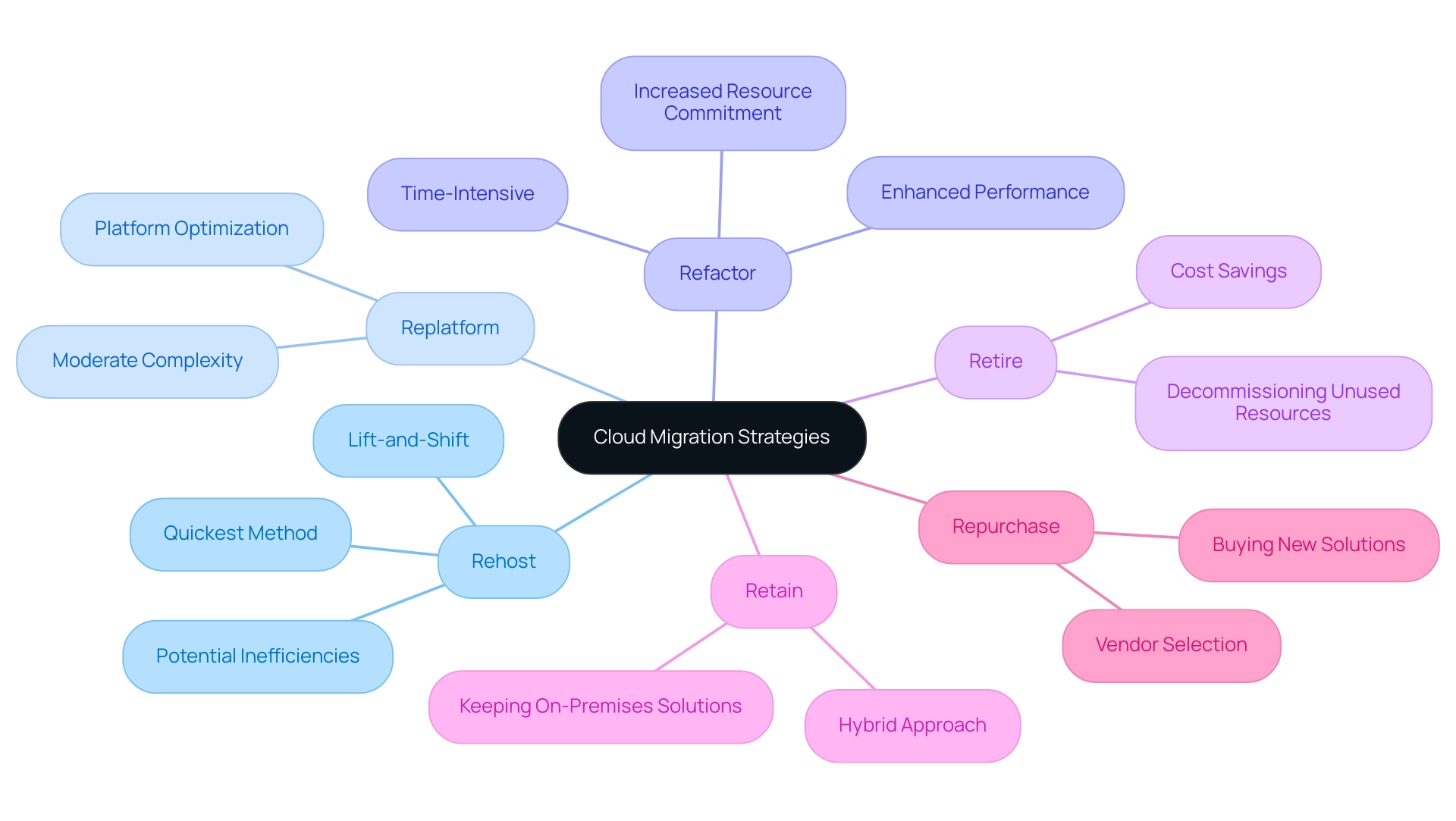
The Importance of Planning in Cloud Migration
Successful transition relies on careful planning, which includes broad approaches to migrating into the cloud, a comprehensive evaluation of current IT infrastructure, the setting of clear business goals, and the recognition of possible risks. With 98% of U.S. organizations now utilizing cloud services for various business operations, an increase from 91% in 2020, the urgency for broad approaches to migrating into the cloud is more critical than ever. Involving stakeholders from various departments is essential; their perspectives will promote alignment on transition objectives and enable smoother changes.
A comprehensive inventory of applications and their dependencies is crucial to understand the broad approaches to migrating into the cloud and the transition necessities and potential impacts on business operations. Additionally, creating a comprehensive timeline and budget is crucial for reducing interruptions during the transition, ultimately aiding in a successful shift to a digital environment. As indicated by Veeam, half of the businesses surveyed recognize that the online environment is essential to contemporary data safeguarding methods, highlighting the necessity for broad approaches to migrating into the cloud.
Furthermore, companies are 57 percent more likely to recruit for advanced skill sets like DevOps and FinOps, emphasizing the necessity for specialized knowledge in the transition process. Furthermore, with over 60% of corporate data currently housed in the cloud, there are major security issues concerning sensitive information, highlighting the need for strong data protection measures during the planning phase.
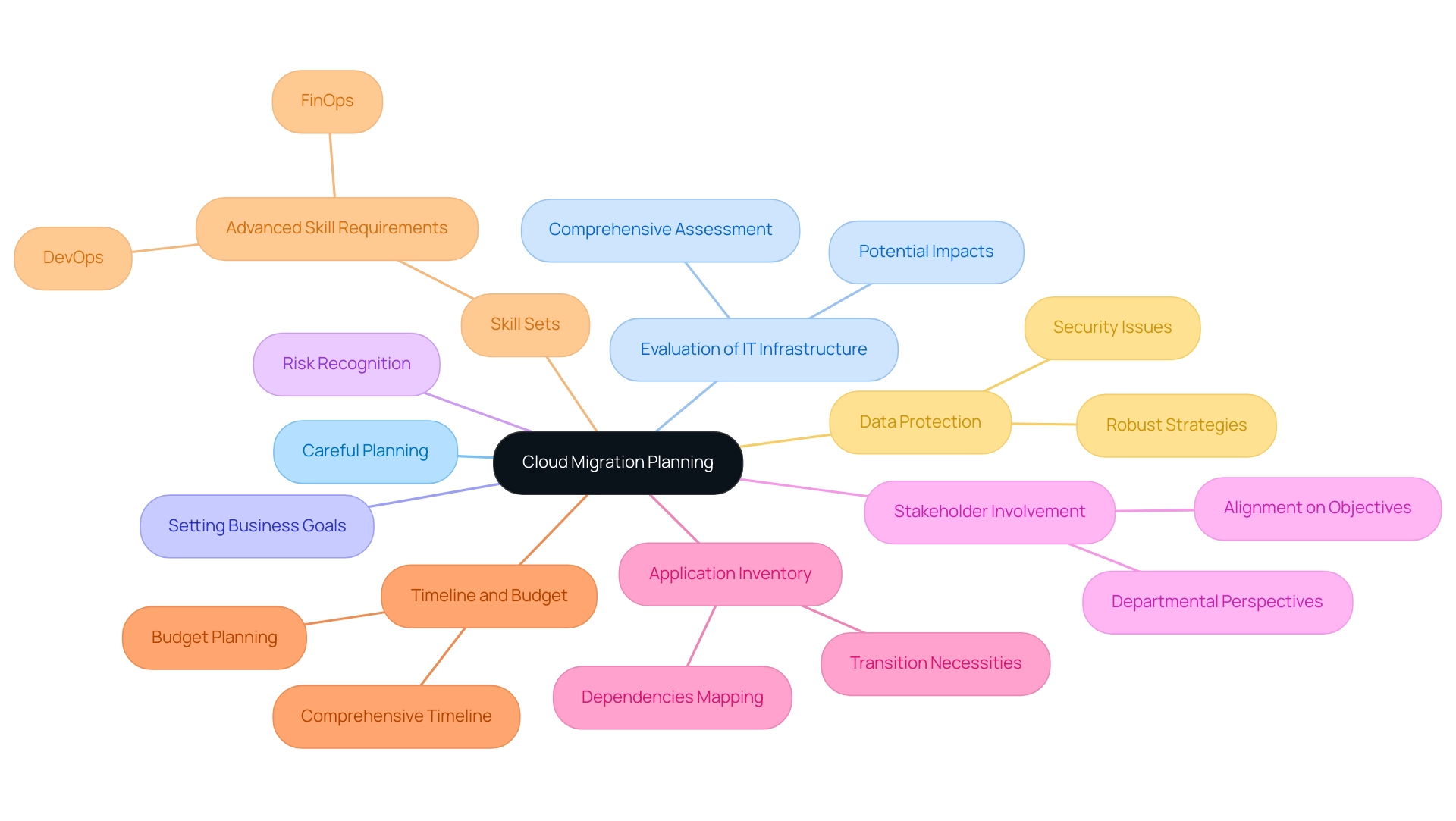
Navigating Challenges in Cloud Migration
Cloud transition offers companies a multitude of challenges, with data security issues being crucial. As emphasized by Veeam, Cloud computing is a contemporary data protection strategy, indicating the necessity for robust security measures throughout the transition process. Sensitive data must be thoroughly protected, which requires the implementation of advanced encryption techniques and secure transfer protocols to safeguard against potential breaches.
Compounding these security challenges are compliance issues; entities must ensure that their service provider adheres to industry-specific regulations to avoid legal repercussions. A significant statistic indicates that 75% of entities report a rise in waste from remote storage, which directly connects to the difficulties of resource distribution and planning during transition. This underscores the importance of careful management to avoid inefficiencies.
Furthermore, integration difficulties often arise when connecting legacy systems to new applications, necessitating additional middleware or custom solutions to ensure seamless functionality. For example, companies such as Drift have effectively lowered expenses by $2.4 million, while Applause experienced a 23% decrease in spending on online services through strategic initiatives. Proactively identifying these challenges is crucial, as it empowers organizations to develop broad approaches to migrating into the cloud and comprehensive mitigation strategies before starting the transition process.
By tackling these issues directly, companies can improve their data transition efforts and protect their information efficiently. Furthermore, it is essential to recognize that the U.S. and Western Europe represent 82% of the global computing market, emphasizing the scale and importance of these transition challenges.
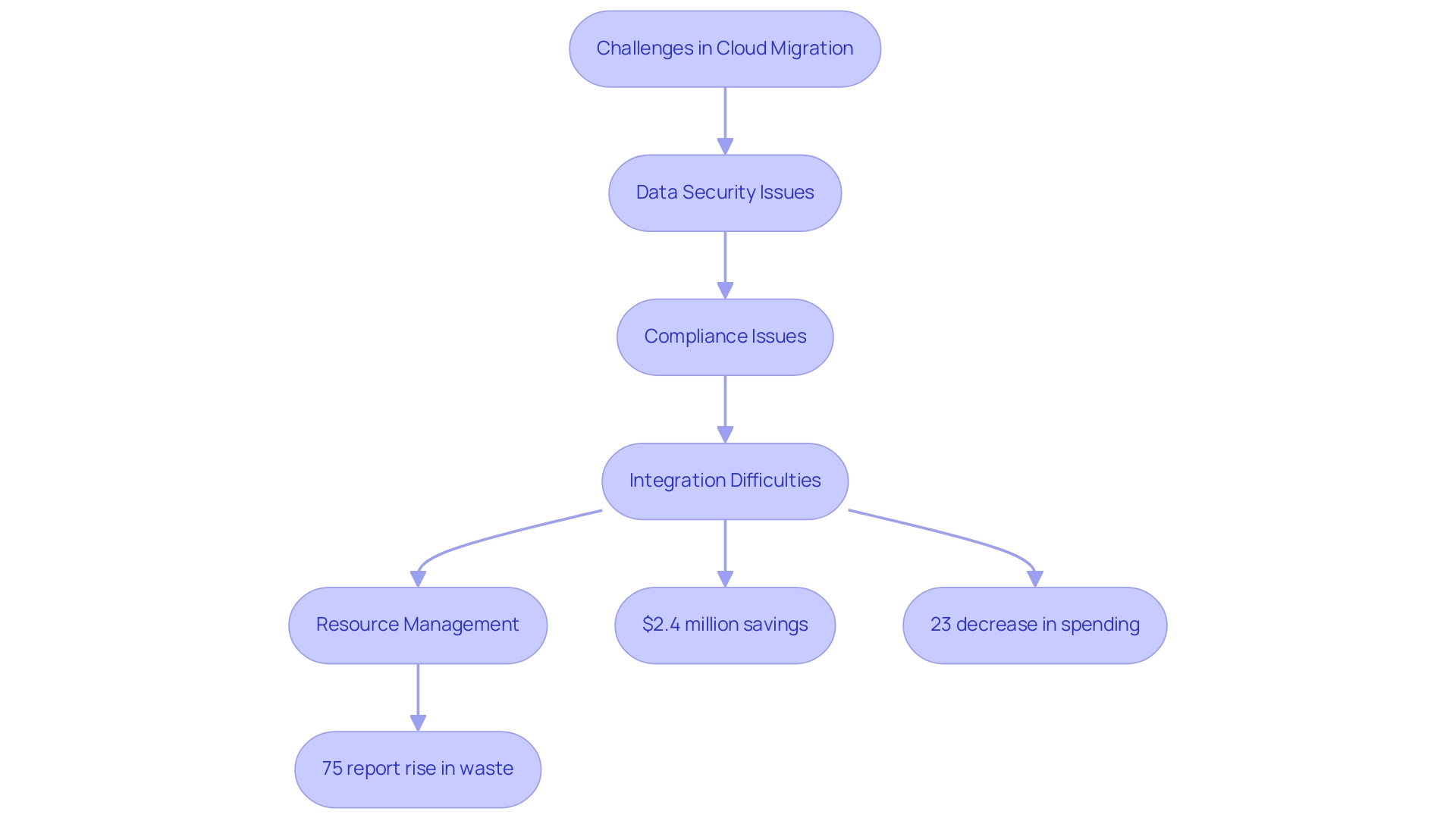
Best Practices for a Successful Cloud Migration
To facilitate a successful cloud transfer, organizations must adhere to several best practices that encompass broad approaches to migrating into the cloud, ensuring a seamless transition and optimal performance. First, conducting thorough assessments of applications is essential to determine their suitability for transfer, allowing businesses to make informed decisions. Security must be prioritized; implementing robust encryption and compliance measures safeguards sensitive data and aligns with industry standards.
Involving stakeholders early in the process promotes alignment and supports buy-in, which is crucial for the project's success. A phased migration approach can further minimize disruptions, enabling teams to address potential issues without impacting overall operations. Continuous performance monitoring, including alerts, analytics, and security measures, is vital post-migration, as it allows organizations to quickly identify and resolve any emerging challenges, ensuring continued efficiency and security.
As highlighted by Veeam,
The digital environment plays a vital part in modern data safeguarding plans, according to half of the surveyed companies.
Significantly, the expansion of Google Cloud’s IaaS offering by 63.7% highlights the growing dependence on online solutions. Moreover, the example of Airbnb demonstrates the effectiveness of these strategies; the company successfully transitioned to a remote infrastructure by partnering with Amazon Web Services (AWS), achieving the scalability necessary to manage increasing demand and ensuring a reliable experience for users.
By embracing these best practices, organizations can significantly enhance their chances of achieving a smooth and successful transition to the cloud by implementing broad approaches to migrating into the cloud.
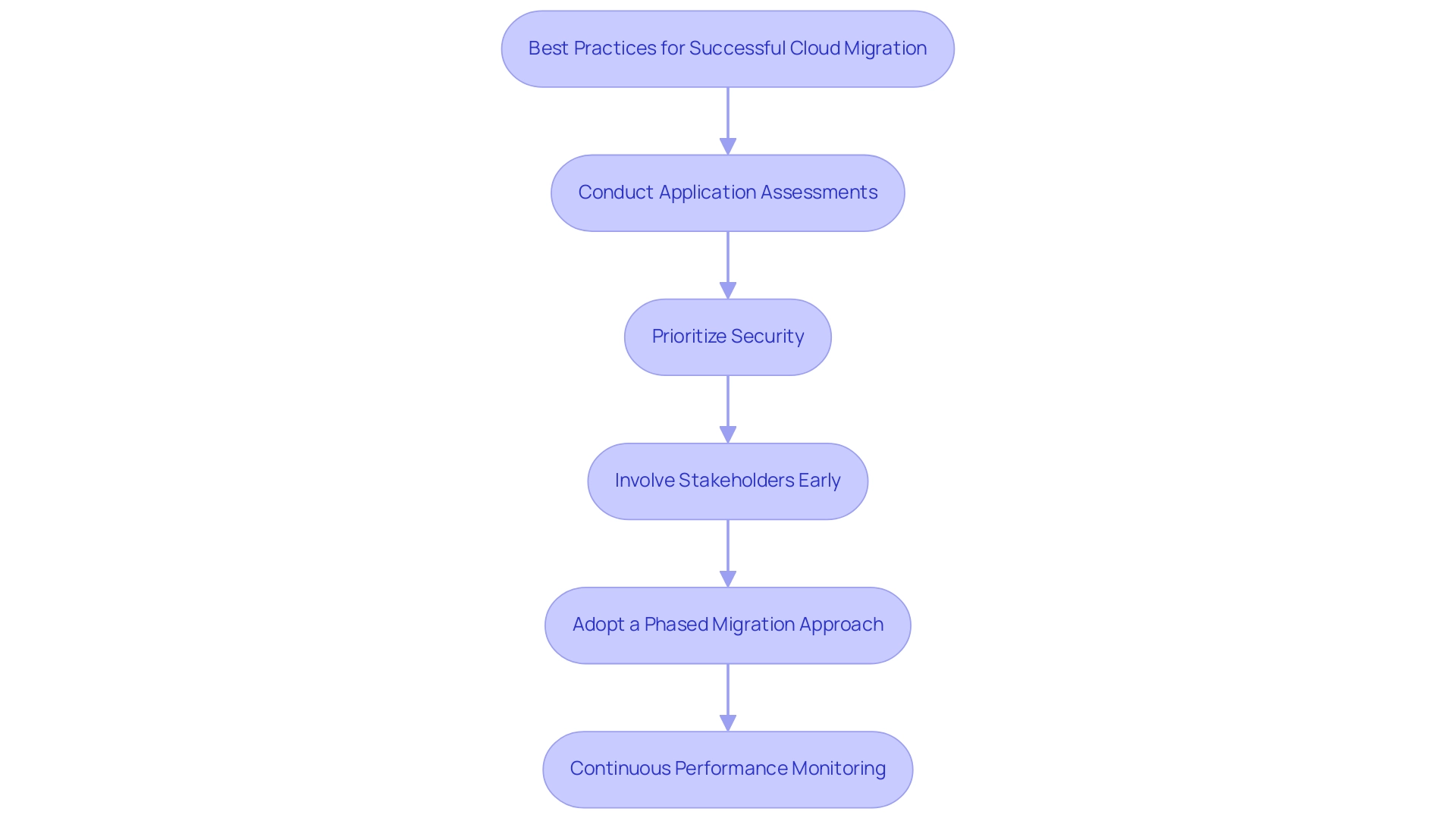
Conclusion
The journey toward cloud migration presents organizations with a transformative opportunity to enhance operational efficiency and drive innovation. As outlined, the strategic transition of data and applications to cloud environments can yield significant benefits, including cost savings and improved scalability. However, navigating this landscape requires a comprehensive understanding of the various migration strategies, collectively known as the 6 Rs, and the associated challenges, such as data security and resource allocation.
Effective planning emerges as a cornerstone of successful cloud migration. Organizations must engage stakeholders, assess their existing IT infrastructure, and develop a detailed timeline and budget to minimize disruptions. By adopting best practices, such as prioritizing security and conducting thorough assessments, companies can ensure a seamless transition that aligns with their operational goals and safeguards sensitive data. The experiences of organizations like Drift and Airbnb highlight the potential for substantial cost reductions and enhanced performance when cloud migration is executed thoughtfully.
In conclusion, as businesses increasingly recognize the importance of cloud solutions, the insights provided in this article serve as a valuable guide for navigating the complexities of cloud migration. Embracing a well-structured approach not only mitigates risks but also positions organizations to leverage the full potential of cloud technologies, ultimately fostering a culture of innovation and resilience in an ever-evolving digital landscape.




